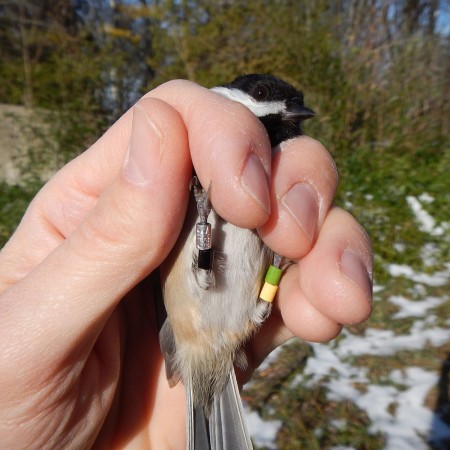
The chickadees at the U of G Arboretum sport black caps like any others. But many of them are also flashing new colours this fall.
Resident members of Poecile atricapillus are being colour banded for potential bird and population studies by campus researchers, says Chris Earley, the arboretum’s interpretive biologist and education co-ordinator.
Outfitting individual chickadees with coloured leg bands will also engage arboretum visitors in a citizen science project by monitoring movement, ecology and behaviour of the popular songbirds. Says Earley: “Have you ever heard someone say they didn’t like chickadees?”
Earlier, he had colour banded a few arboretum birds for an undergraduate ornithology class. That small project sparked a bigger idea: Why not band all of the arboretum’s roughly 200 chickadees?
Colour banding makes it easier to identify individual birds than using conventional aluminum bands that require researchers and conservation officials to retrap and release specimens.
Slipping tiny coloured “ankle bracelets” onto the chickadees’ legs — two on each leg — allows anyone to record each bird’s signature colour combination and arrangement with the naked eye or with a set of binoculars.
“It would be great to have a colour-banded population in the arboretum for students, faculty and the general public to use for field science,” says Earley.
Researchers and birdwatchers might track individual chickadees to study flock pecking order, feeding, territory and mating behaviour.
A page on the arboretum website will keep track of the project. Earley hopes to see an app developed to allow users to record sightings into their smartphones, providing information for the chickadee database.
The project allows visitors to be “part of a big long-term study right on campus. That’s a pretty cool thing to be able to do. They can learn how things are studied here.”
Earley says black-capped chickadees are perfect subjects because they are resident birds and form winter flocks that visit bird feeders. Plus, they aren’t nervous around human observers.
Some 15 to 20 flocks of chickadees stick fairly close to the arboretum all winter. By the end of November, Earley had banded just over 100 birds.
He catches them in wire mesh boxes baited with seeds. Mounted on feeders in the arboretum, the boxes are basically walk-in traps that leave the birds unharmed and allow Earley to retrieve and release them.
Each chickadee gets two different-coloured bands on each leg, with the combination recorded in a lengthening chart of individual birds. Earley also records weight, wing length and age.
He’s getting help from Alexandra Kocher, who completed an ecology degree in 2014 and is now working as an intern at the arboretum.
“By banding them, we’re able to see where they’re going in the arboretum and how old they are,” she says. “Once we have a big chunk of chickadees banded, we can see who’s mating with whom.”
This project will also feed into Project FeederWatch involving birdwatchers recording information from feeders across North America. That project is run by Bird Studies Canada and the Cornell Lab of Ornithology.
“The more we learn, the better for wildlife and us,” says Earley.